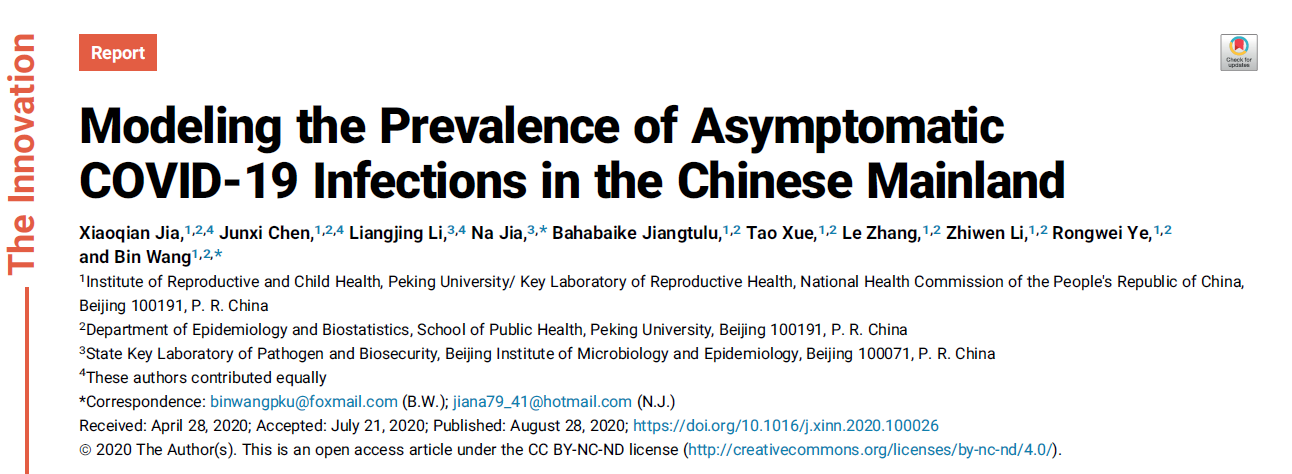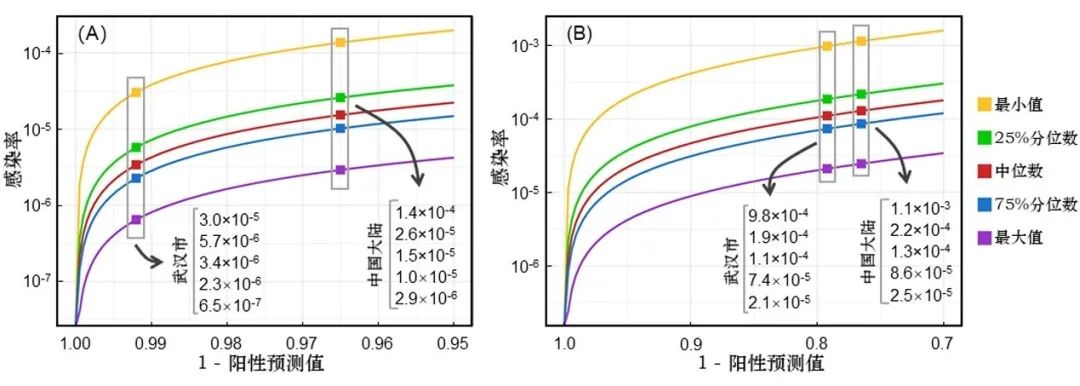
Featured research
The Innovation | Modeling the Prevalence of Asymptomatic COVID-19 Infections in the Chinese Mainland
The Innovation | Modeling the Prevalence of Asymptomatic COVID-19 Infections in the Chinese Mainland

First affiliated institution: Peking University
First author: Xiaoqian Jia
Corresponding authors: Bin Wang (Peking University), Na Jia (Academy of Military Medical Sciences)
Journal: The Innovation, IF2022 = 33.1, CAS 1st Quartile
Article information: Jia X#, Chen J#, Li L#, Na Jia*, Jiangtulu B, Xue T, Zhang L, Li Z, Ye R, Wang B*, Modeling the Prevalence of Asymptomatic COVID-19 Infections in the Chinese Mainland. The Innovation, 2020, 1, 100026. https://doi.org/10.1016/j.xinn.2020.100026
Main page: https://www.sciencedirect.com/science/article/pii/S2666675820300266

COVID-19 has become a global pandemic and a major public health issue faced by all countries. By mid-March 2020, the COVID-19 epidemic in mainland China had been effectively controlled, making it the first to enter the "post-epidemic" phase. Amid the gradual resumption of work, production, and schooling in various regions, as well as the continuous return of overseas personnel, the key to combating the epidemic is the sustained and effective control of COVID-19 transmission. At this time, the virus transmission caused by asymptomatic carriers has become a focus of attention, especially the true proportion of this group, which is crucial for supporting relevant decision-making.
From April 1, 2020, the National Health Commission of China has strengthened the isolation and management of asymptomatic carriers, reporting daily the specific numbers of such cases and their progression to symptomatic cases, and conducting large-scale screening of asymptomatic carriers to obtain accurate infection rates in different regions. According to literature reports and the usage instructions provided by reagent kit manufacturers, the sensitivity and specificity of the current nucleic acid test kits are already very high. However, due to reasons such as nucleic acid contamination and non-specific amplification during the testing process, the specificity of the tests still cannot reach 100%. According to Bayes' theorem, when the infection rate in the population is extremely low, the positive predictive value of the screening will also significantly decrease, meaning that the proportion of true positives among those who test positive will drop to a very low level (correspondingly increasing the false positive rate).
Researchers from the School of Public Health, Peking University, and the Academy of Military Medical Sciences found that during the period from April 1 to May 14, a total of 1,303 asymptomatic carriers were identified among the newly positive nucleic acid test cases in mainland China. Of these, 43 subsequently developed COVID-19 symptoms, resulting in a progression rate of 3.3% (43/1303). In Wuhan, 897 asymptomatic carriers were discovered, with only 7 subsequently developing symptoms, resulting in a progression rate of 0.8% (7/897). Both of these rates are lower than the progression rates of asymptomatic carriers from overseas during the same period, which were 58.9% (mainland China) and 77.8% (Heilongjiang Province), as well as the rates reported in the literature, which range from 71% to 100%.
Previous studies have shown that the viral load of asymptomatic carriers is comparable to that of symptomatic patients, and the duration of viral shedding can even be longer in asymptomatic carriers. More than 70%, and in some cases up to 100%, of asymptomatic carriers may subsequently develop symptoms and be diagnosed as symptomatic patients. Only a small proportion of asymptomatic carriers will never develop any symptoms (Note: this group is defined here as "covert infections" to avoid confusion with the commonly publicized concept of "asymptomatic carriers" of COVID-19).
Assuming an incubation period of 5.2 days, the theoretical proportion of asymptomatic carriers developing symptoms during the study period should be 92.5% in mainland China and 95.1% in Wuhan. For imported asymptomatic carriers, the proportions should be 100% in mainland China and 98.6% in Heilongjiang Province. Based on these estimates, the actual proportions of asymptomatic carriers who did not develop symptoms are remarkably high: 99.2% in mainland China and 96.5% in Wuhan, both much higher than the proportions among imported cases during the same period, which were 40.3% in mainland China and 22.2% in Heilongjiang Province. If the pathogenicity of the COVID-19 virus has not significantly decreased, the difference in the non-progression proportions may be attributed to a certain proportion of false positives.
Assuming that the nucleic acid test kits have high sensitivity and specificity, simulation results indicate that the asymptomatic infection rates in mainland China and Wuhan are 15 per million and 3.4 per million, respectively. If it is assumed that 20% of asymptomatic carriers are covert infections, the asymptomatic infection rates increase to 1.3 per ten thousand and 1.1 per ten thousand, respectively (Figure 1). Assuming the population of Wuhan is 10 million, under the two simulation scenarios, there would be approximately 340 and 1,100 asymptomatic carriers in the area, respectively. In summary, the asymptomatic infection rate in mainland China during the later stage of the epidemic is extremely low. Nevertheless, the Chinese government has spared no effort in conducting large-scale screening and implementing the principle of “testing everyone who needs to be tested and treating everyone who needs to be treated,” making great efforts to control the spread of the epidemic.

Figure 1. The estimated prevalence of asymptomatic carriers in the context of no subclinical infections (A) and assuming 20% subclinical infections (B). The legend indicates the specificity values.
The formulation of specific control measures for asymptomatic carriers is related to the epidemic period in which the pandemic is situated. When the infection rate in the population is extremely low, if large-scale community screening is conducted, it is necessary to re-test those who test positive and confirm the results by integrating various detection outcomes. This study has certain limitations, including the assumption that all subjects' results were obtained from a single test, the lack of real sensitivity and specificity data for the test kits, and the absence of detailed clinical detection data for asymptomatic carriers.
Overall, this study, from a statistical analysis perspective and combined with the clinical and epidemiological characteristics of asymptomatic carriers, explains the possible reasons for the lower conversion rate of asymptomatic carriers in the later stages of the epidemic. The related recommendations can provide a reference for other regions in the late stages of the epidemic to formulate prevention and control policies.
Acknowledgments:
We would like to thank the China Cohort Consortium (https://chinacohort.bjmu.edu.cn/) for their collaborative assistance. We also express our gratitude for the support from the National Natural Science Foundation of China and the Key R&D Projects of the Ministry of Science and Technology of China. Special thanks to Dr. Xian Zhang for providing crucial support in the design of this study. All the authors of this paper have been collaboratively offering scientific consultancy to relevant national departments for epidemic prevention and control since the onset of the pandemic.
Author Biography:
First Author:
Xiaoqian Jia, Junxi Chen, and Liangjing Li are co-first authors of this paper, and Na Jia and Bin Wang are co-corresponding authors.
Corresponding authors:
Bin Wang, Associate Professor/Researcher with tenure at the Institute of Reproductive Health, School of Public Health, Peking University. His main research areas are environmental health, exposomics big data, and artificial intelligence. He employs multidisciplinary research methods to elucidate the impacts and mechanisms of environmental pollution exposure on reproductive health, and to construct health risk assessment models. To date, he has led three projects funded by the National Natural Science Foundation of China (General Program and Youth Fund), and played a key role in three National Key R&D Program projects. He has published 55 papers as the first or corresponding author in international authoritative journals such as Environmental Health Perspectives, Environmental Science & Technology, and The Innovation (H-index = 42, with over 6,500 citations). He serves as a thematic editor for the top journal in the field of environmental health, Environmental Science & Technology, and is involved as an editorial board member for several well-known domestic and international journals (The Innovation, Environment International, Environment & Health, Eco-Environmental Health, China CDC Weekly, and Journal of Environmental Hygiene). He has introduced the undergraduate course "Exposomics," the graduate course "Environmental Exposomics," and the international public health master's course "Environment & Health." He is the leader of the "Environment and Population Health" group of the China Cohort Consortium and the Deputy Secretary-General of the Environmental and Reproductive Health Special Committee of the Environmental Mutagen Society of China. He has received the second prize from the Beijing Preventive Medicine Association for Scientific and Technological Progress and the title of "Outstanding Individual in the National Scientific and Technological System for Fighting COVID-19."
Na Jia, Associate Researcher at the Institute of Microbiology and Epidemiology, Academy of Military Medical Sciences. In recent years, she has focused on the surveillance and tracing of emerging zoonotic diseases. She has published over 50 SCI papers in international mainstream academic journals such as Nature, Cell, NEJM, and Lancet Infect Dis. She has received one First Prize of Beijing Science and Technology Award and one Second Prize of the National Natural Science Award.
Contributed by | Professor Bin Wang's Team (Peking University)
Reviewed by | Bin Wang

